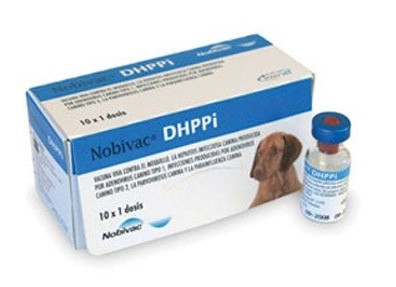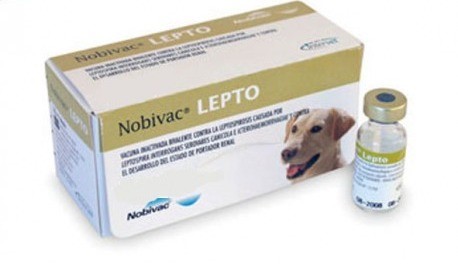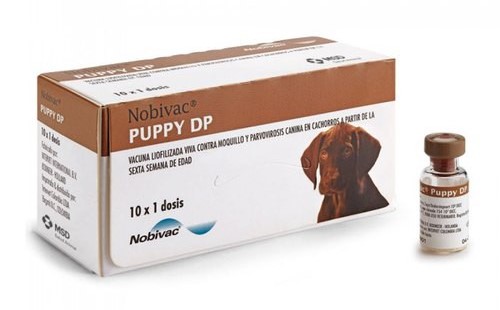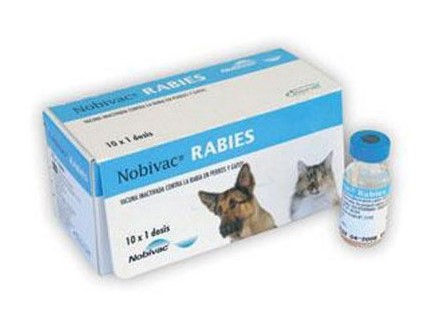

Novibac DHPPI
Presentation
Live vaccine containing >104.0 TCID50 Canine distemper virus; >104.0 TCID50 Canine adenovirus type 2; >107.0 TCID50 Canine parvovirus, >105.5 TCID50 Canine parainfluenzavirus per dose after reconstitution.
Uses
For active immunisation of dogs to prevent mortality and clinical signs caused by canine distemper virus infection. To reduce clinical signs of infectious hepatitis and viral excretion due to canine adenovirus type 1 infection. To prevent mortality, clinical signs and viral excretion following canine parvovirus infection. To reduce clinical signs and viral excretion caused by canine parainfluenza virus infection and to reduce clinical signs of respiratory disease and viral excretion following adenovirus type 2 infection.
Specific claims
An onset of immunity to the canine distemper virus, canine adenovirus and canine parvovirus vaccine components of 1 week and an onset of immunity of 4 weeks to the canine parainfluenza virus vaccine component has been demonstrated following use of the vaccine.
A duration of immunity of at least three years has been established for the canine distemper virus, canine adenovirus and canine parvovirus vaccine components. The duration of immunity for the canine parainfluenza virus component has not been demonstrated, but an anamnestic response is produced in dogs given a revaccination one year after basic vaccination. Annual revaccination with the canine parainfluenza virus vaccine component is recommended.
Dosage and administration
The contents of one vial of reconstituted vaccine should be injected subcutaneously. Reconstitute immediately prior to use by the addition of the contents of one vial (1.0 ml) of Nobivac Lepto 2, Nobivac Rabies, or Nobivac Solvent.
Avoid contamination of vaccine with traces of chemical sterilising agents. Do not use chemicals such as disinfectant or spirit to disinfect the skin prior to inoculation.
Primary coursevaccination
A single injection should establish active immunity to canine distemper, infectious canine hepatitis and disease caused by canine parvovirus infection in dogs of 10 weeks of age or older. Where earlier protection is required a first dose may be given to puppies from 6 weeks of age, but because maternally derived passive antibody can interfere with the response to vaccination a final dose at 10 weeks of age or older is generally recommended. For an optimal response to the parainfluenza component, animals should be vaccinated twice, 2-4 weeks apart with the final vaccination at 10 weeks of age or more.
Booster vaccination
It is recommended that dogs be revaccinated with canine distemper virus, canine adenovirus and canine parvovirus every 3 years and against canine parainfluenzavirus every year.
It was not possible to produce clinical signs of kennel cough by parainfluenza challenge in adult dogs and duration of immunity could not therefore be demonstrated, but an anamnestic response was seen in dogs given a booster one year after primary vaccination.
Revaccination against parainfluenza is recommended prior to exposure to high risk environments (such as kennelling, showing or mixing with dogs of unknown vaccination history).
Further information:
Experience has shown that the maternal antibody status of pups within a litter varies greatly and reliance should not be placed on serological examination of the bitch alone.
A good immune response is reliant on the reaction of an immunogenic agent and a fully competent immune system. The immunogenicity of the vaccine antigen will be reduced by poor storage or inappropriate administration. Immunocompetence of the animal may be compromised by a variety of factors including poor health, nutritional status, genetic factors, concurrent drug therapy and stress.
Can be used in pregnant bitches which have previously been vaccinated with the CDV (strain Onderstepoort), CAV2 (strain Manhattan LPV3), CPV (strain 154) and CPi (strain Cornell) antigens included in the Nobivac vaccine series.
Contra-indications, warnings, etc.
Only healthy dogs should be vaccinated. The vaccine may not be effective in dogs incubating the disease at the time of vaccination.
Some animals may be immunologically incompetent and fail to respond to vaccination. Animals that have received the corresponding anti-serum or immunosuppressive drugs should not be vaccinated until an interval of at least 4 weeks has elapsed.
A diffuse swelling, up to 5 mm in diameter, may be observed at the site of injection. Occasionally this swelling may be hard and painful and last for up to 3 days post injection.
After subcutaneous administration with Nobivac Rabies and/or Nobivac Lepto 2, a transient palpable nodule may occasionally occur at the site of injection.
In the rare event of a hypersensitivity reaction occurring following vaccination, administer an antihistamine, corticosteroid or adrenaline, without delay and by the most immediate route.
After administration of an overdose, a response similar to that following a single dose may be seen. In some dogs the swelling may be more painful or may be observed for a longer period.
The canine parvovirus vaccine strain may be shed at very low levels for up to 8 days after inoculation. However there is no evidence of any reversion to virulence of the vaccine strain and therefore no need to separate unvaccinated dogs from contact with recently vaccinated individuals.
No information is available on the use of this vaccine with any other, except Nobivac Lepto 2 or Nobivac Rabies. These liquid vaccines can be used to reconstitute the freeze-dried Nobivac DHPPi. It is recommended that no other immunological product should be administered within 14 days before or after vaccination with Nobivac DHPPi.
Do not mix with any other medicinal product except Nobivac Lepto 2 or Nobivac Rabies.
The efficacy of the CDV, CAV2, CPV and CPi components of the vaccine may be reduced due to maternal antibody interference. However, the vaccine has been proved to be of benefit against virulent challenge in the presence of maternal antibody levels to CDV, CAV2, CPV and CPi that are likely to be encountered under field conditions.
Withdrawal period
Not applicable.
FOR ANIMAL TREATMENT ONLY. KEEP OUT OF REACH AND SIGHT OF CHILDREN.
Pharmaceutical precautions
Store between +2°C and +8°C. Do not freeze. Protect from light.
After reconstitution: use within 30 minutes.
Care should be taken to avoid prolonged or repetitive exposure to high ambient temperatures following withdrawal from the refrigerator prior to use – in hot summer conditions vaccine potency can be severely reduced within a few hours.
Disposal advice
Dispose of waste material by boiling, incineration or immersion in an appropriate disinfectant approved for use by the competent authorities.
Legal category
POM-V
Package quantities
Clear, Glass Type I (Ph.Eur.) single vials with halogenobutyl rubber stopper, closed with a colour-coded aluminium cap. Cartons containing 10 or 50 vials.

Novibac Lepto
The bivalent vaccine against leptospirosis. Dogs are protected against clinical disease and also against becoming renal shedders after challenge.
Composition
Each dose contains ≥ 40 hamster PD80 inactivated bacteria of strain Ca-12-000 of L.Canicola and ≥ 40 hamster PD80 inactivated bacteria of strain 820K of L.Icterohaemorrhagiae.
Formulation
Liquid vaccine
Indications
Active immunisation against Leptospirosis caused by L.Icterohaemorrhagiae and L.Canicola of Leptospira interrogans.
Vaccination
Nobivac Lepto is indicated for a basic vaccination schedule with a first vaccination at 8-9 weeks of age, followed by a booster at 12 weeks of age, and for annual revaccination. Vaccination with Nobivac Lepto however is part of a comprehensive vaccination programme. Several alternatives exist. (See vaccination programme for dogs)
Method of administration
Inject 1 ml of Nobivac Lepto subcutaneously. Nobivac Lepto can also be used to reconstitute Intervet’s freeze dried vaccines Nobivac Parvo-C, Nobivac Puppy DP, Nobivac DH, Nobivac DHP, Nobivac DHPPi , Nobivac Pi and Nobivac PPi.
Presentation
Boxes containing 10 or 50 vials of Nobivac Lepto, or boxes containing 5 or 25 vials of Nobivac Lepto in combination with an equal number of vials with Nobivac DHP or Nobivac DHPPi.
Storage
Store at a temperature of 2-8°C.
Further information
Nobivac Lepto is safe in pregnant bitches.
Precautions
Occasionally a mild, anaphylactic-type hypersensitivity reaction may occur after vaccination. This type of reaction can occur after the injection of any foreign protein and is, in most cases, self-limiting.

Novibac Puppy DP
Combined Freeze-Dried Canine Distemper and Parvovirus Vaccine
INDICATION
Active immunisation of young puppies against canine distemper virus, and canine parvovirus infection.
Thepuppy vaccination programme can becompleted from 10weeks of age and followingcompletion, the components of Nobivac Puppy DP have been shown to protect against canine distemper virus and canine parvovirus for at leastthree years, whilst onset of immunity is one week following administration. Puppy DP can be used at 6weeks of age followed by Nobivac DHP/DHPPi at 10 weeks of age.
DOSAGE AND ADMINISTRATION
Reconstitute each single dose (vial) of the vaccine with one vial(1mL) of Nobivac Diluent or Nobivac Lepto I and administer by subcutaneous injection. Afterreconstitution, the vaccine should be used within 30 minutes.
Primary vaccination
A first dosemay be given topuppies from 6 weeks of age, but because maternally derived antibodies can interfere with response to vaccination, a final dose should be given 4 weeks later i.e. at 10 weeks of age or older. If the first dose is given at 10 weeks of age or older, only one dose is required.
Booster vaccination
Dogs should berevaccinated every 3 years.
PRECAUTIONS and WARNINGS
- Only healthy dogs should be vaccinated.
- Sterileequipment should be used for administration but avoid contamination of vaccine with traces of disinfectant or spirit.
ADVERSE REACTIONS
Following subcutaneous administration, a diffuse swelling up to 5mm in diameter may be observed at the site of injection. Occasionally this swelling may be hard and painful and last up to 3 dayspost injection.
In rare cases, a transient rise in body temperature may occur.
Hypersensitivity reactions are rare, but as with all vaccines, may occasionally be encountered. In this event, administration of an antihistamine, corticosteroid or adrenaline by the most immediate route may be indicated.
STORAGE
Store in arefrigerator between 2°C and 8°C. Oncereconstituted use within 30 minutes.
Nobivac Diluent may be stored at room temperature.
FURTHER INFORMATION
The efficacy of the CDV, CAV2 and CPV components of the vaccine may be reduced due to maternal antibody interference. However, the vaccine has proven to be of benefit against virulent challenge in the presence of maternal antibody levels to CDV, CAV2 and CPV that are likely to be encountered under field conditions.
Experience has shown that the maternal parvovirus antibody status of pups within a litter varies greatly and reliance should not be placed on serological examination of the bitch alone.
Agood immune response is reliant on the reaction of a fully competent immune system to an immunogenic agent.The immunogenicity of thevaccine antigen will be reduced by poor storage or inappropriate administration.
Immunocompetence of the animal may be compromised by a variety of factors including poor health, nutritional status, genetic factors, concurrent drug therapy and stress.

Nobivac Rabies
The highly stable inactivated, adjuvanted vaccine against Rabies that offers complete protection.
Composition
Each dose contains ≥ 2 mouse potency I.U. of inactivated rabies virus, strain Pasteur, adjuvated with aluminiumphosfate.
Formulation
Liquid vaccine.
Indications
Vaccination against rabies.
Vaccination
A single vaccination at 12 weeks of age will protect both cats and dogs for a period of at least 3 years. If animals are vaccinated for the first time below the age of 12 weeks, there is possible interference with maternal antibodies, and for this reason, a revaccination should be performed at the age of 12 weeks or older. Vaccination with Nobivac Rabies however is part of a comprehensive vaccination programme. Several alternatives exist. (See vaccination programme for dogs, See vaccination programme for cats).
Method of administration
Inject one vial of Nobivac Rabies subcutaneously or intramuscularly. Nobivac Rabies can also be used to reconstitute Intervet’s freeze dried vaccines Nobivac Parvo-C, Nobivac Puppy DP, Nobivac DH, Nobivac DHP, Nobivac DHPPi, Nobivac Pi, Nobivac PPi, Nobivac Ducat and Nobivac Tricat.
Presentation
Boxes containing 10 or 50 vials with one dose of Nobivac Rabies, or vials containing 10 doses of Nobivac Rabies each.Storage
Store at a temperature of 2-8°C. Do not freeze.
Further information
Nobivac Rabies is safe in pregnant bitches.
Precautions
Occasionally a mild, anaphylactic-type hypersensitivity reaction may occur after vaccination. This type of reaction can occur after the injection of any foreign protein and is, in most cases, self-limiting.